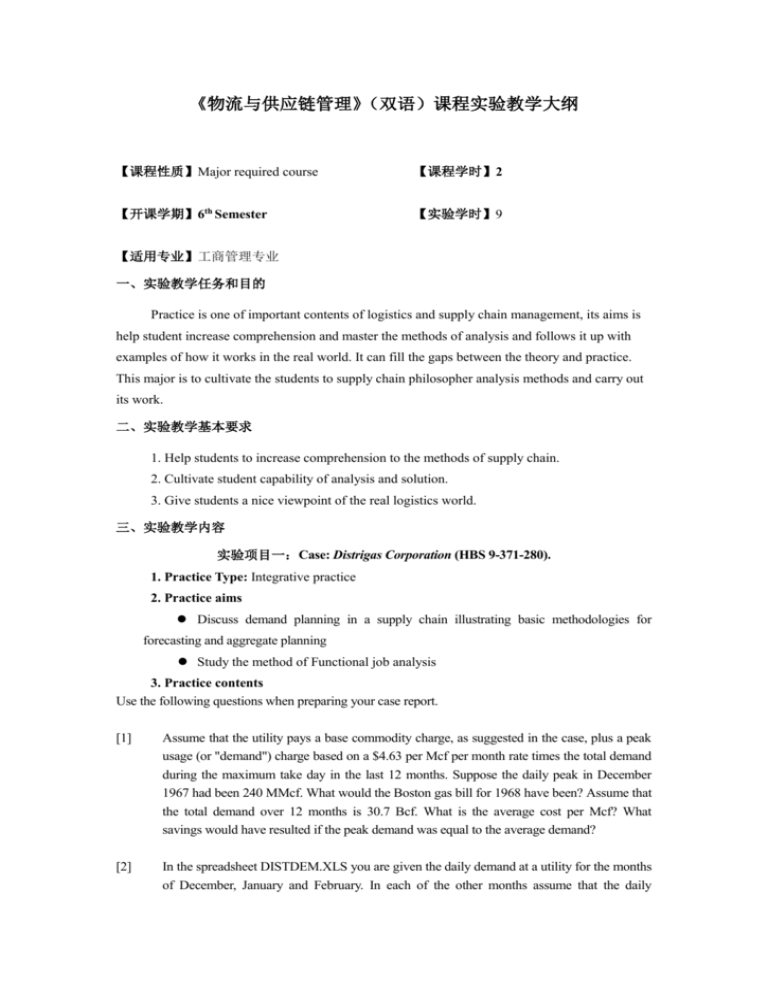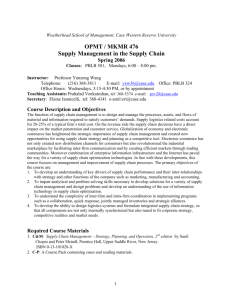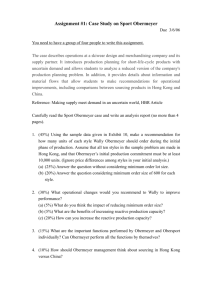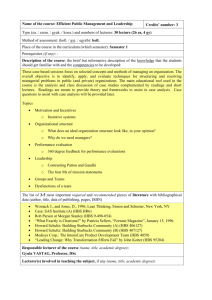《物流与供应链管理》(双语)课程实验教学大纲
advertisement

《物流与供应链管理》 (双语)课程实验教学大纲 【课程性质】Major required course 【课程学时】2 【开课学期】6th Semester 【实验学时】9 【适用专业】工商管理专业 一、实验教学任务和目的 Practice is one of important contents of logistics and supply chain management, its aims is help student increase comprehension and master the methods of analysis and follows it up with examples of how it works in the real world. It can fill the gaps between the theory and practice. This major is to cultivate the students to supply chain philosopher analysis methods and carry out its work. 二、实验教学基本要求 1. Help students to increase comprehension to the methods of supply chain. 2. Cultivate student capability of analysis and solution. 3. Give students a nice viewpoint of the real logistics world. 三、实验教学内容 实验项目一:Case: Distrigas Corporation (HBS 9-371-280). 1. Practice Type: Integrative practice 2. Practice aims Discuss demand planning in a supply chain illustrating basic methodologies for forecasting and aggregate planning Study the method of Functional job analysis 3. Practice contents Use the following questions when preparing your case report. [1] Assume that the utility pays a base commodity charge, as suggested in the case, plus a peak usage (or "demand") charge based on a $4.63 per Mcf per month rate times the total demand during the maximum take day in the last 12 months. Suppose the daily peak in December 1967 had been 240 MMcf. What would the Boston gas bill for 1968 have been? Assume that the total demand over 12 months is 30.7 Bcf. What is the average cost per Mcf? What savings would have resulted if the peak demand was equal to the average demand? [2] In the spreadsheet DISTDEM.XLS you are given the daily demand at a utility for the months of December, January and February. In each of the other months assume that the daily sendout does not exceed 120 MMcf. Assume that the total demand over 12 months is 30.7 Bcf. With cost data as given in [1] and the case (assume that the utility wants Distrigas to store the LNG until the beginning of the peak season and that the utility is located within 75 miles), how much LNG should the utility purchase from Distrigas? How should the utility use this LNG (which days)? What is the annual cost of such a policy? In general the utility will have to make decisions based on forecasts. How would you suggest the utility decide the purchase and use of LNG from Distrigas? [3] What do the utilities gain from the existence of Distrigas? What would be a suitable business strategy for Distrigas? By this strategy, what should Distrigas be able to do particularly well, i.e., what capabilities must Distrigas build? What are the risks that Distrigas faces? [4] What are the advantages and disadvantages of alternative LNG inventory possibilities? Which of the alternatives would you recommend? Why? Please include a cost/benefit analysis. Use the discount factor and resale assumptions in Exhibit 10. Readings 1. Distrigas Corporation 2. Getting the Most from Planning Technologies, Mohan Sodhi, Supply Chain Management Review, Special Global Supplement, Winter 2000 3. Chapter 7, 8 in C&M. 实验项目二:Case: Sport Obermeyer (HBS# 9-695-022). 1. Practice Type: Integrative practice 2. Practice aims Develop the notion of Tailored Purchasing based on the uncertainty of product demand Understand the role that contracts play in accurate response and actions that a supply chain can take to increase profits through accurate response 3. Practice contents Use the following questions when preparing your case report. [1] Using the sample data in Exhibit 10, make a recommendation for how many units of each style Wally Obermeyer should order during the initial phase of production. Assume that there is no minimum order size requirement, and that Obermeyer’s initial production commitment must be at least 10,000 units. Assume that an initial order of 10,000 units leaves sufficient capacity for the second order. [2] Using the sample data in Exhibit 10, make a recommendation for how many units of each style Wally Obermeyer should order during the initial phase of production. Assume that all ten styles in the sample problem are made in Hong Kong (a minimum commitment of 600 units per style ordered), and that Obermeyer’s initial production commitment must be at least 10,000 units. Ignore price difference among styles in your initial analysis. Clearly spell out the methodology you have used to make your ordering decisions in an exhibit. Spell out the logic behind your methodology. Note that I am not looking for one optimal solution. My focus will be on your thinking about how such an issue can be approached. [3] Can you come up with a measure of risk associated with your ordering policy? This measure of risk should be quantifiable. [4] Repeat your methodology now assuming that all ten styles are made in China. What differences (if any) result? [5] What operational changes would you recommend to Wally to improve performance? Clearly list the expected benefits from each change. Please try and be very specific in terms of the changes and benefits in response to this question. [6] How should Obermeyer management think (both short term and long term) about sourcing in Hong Kong versus China. What sourcing policy would you recommend? We will discuss the domestic transportation industry and consider the different modes available. We will motivate the link between transportation and inventory costs in the design of transportation networks. We will also consider different problems that are relevant when making transportation decisions. Readings 1. Making Supply Meet Demand in an Uncertain World, Harvard Business Review, May-June 1994 (#94302). 2. Sport Obermeyer 3. Merloni Elettrodomestici SpA. 4. Chapter 13 in C&M. 实验项目三:Case: Applichem (A) (HBS# 9-685-051) 1. Practice Type: Integrative practice 2. Practice aims Develop a framework for facility location decisions Discuss key factors that affect costs and customer service when making shipping decisions Develop the notion of Tailored Transportation and discuss its applications 3. Practice contents Use the following questions when preparing your case report. [1] Compare the performance of Applichem's six Release-ease plants. Please be specific about the measures of plant productivity selected by you and why they are important. [2] Why are some plants "better" performers than others? List the factors that you feel affect performance. How should plant performance be compared? [3] You are provided a workbook APPLICHE.XLS to help you evaluate production and distribution decisions. All costs are in 1000’s of US$. Data contained is from Exhibits 2, 4, 5 of the case and is as follows: Variable cost per 100,000 lb.: Calculated from Exhibit 2 using raw materials, direct labor, waste treatment and supplies as the components. The costs are given in 1000’s of $ per 100,000 lb. Fixed cost: Remaining costs are treated as fixed costs and the fixed cost per plant is obtained by multiplying the remaining costs by the volume produced in 1982. The costs are in 1000’s of $. Transportation costs: Obtained from Exhibit 5. The costs are given in 1000’s of $ per 100,000 lb. Import duties: Obtained from exhibit 5. The worksheet assumes that duties are charged based on the production cost in the source country. Thus the duties for entry into Mexico would differ if the source plant is Frankfurt or Gary. Demand: The demands assumed by region are Mexico Canada Latin America Europe Asia Pacific U.S.A 3.0 million pounds 2.6 million pounds 16.0 million pounds 20.0 million pounds 11.9 million pounds 26.4 million pounds Exchange rates: Obtained from Exhibit 6. Price Indices: Obtained from Exhibit 6. All input data is contained in the worksheet APPLICHE. All cost calculations are based on the costs given in 1982 US$. The basic assumption is that the technology at the plants has not changed significantly in the specified six years. To evaluate variable and fixed costs for a given year (between 1977 and 1982) simply click on the button Calculate Costs in the worksheet APPLICHE. A dialog box will appear asking you for the year for which cost calculations are to be made. Enter the year (say 1981) and click OK. All calculations are done automatically and the costs in 1981 US$ are obtained. The variable and fixed costs are calculated and appear on sheet1 along with the demand by region. These can then be used as input to any optimization model. The adjustments to cost are as follows: COST 198219XX = COST 1982 * ( EXCHANGRT 1982 PRICEINDEX 19XX )* ( ) EXCHANGRT 19XX PRICEINDEX 1982 For example the raw material cost in Mexico in 1982 was $75.05 per hundred pounds of release ease. This translates to 5.05*96.5 Pesos in 1982 which is equivalent to 75.05*96.5*(124.4/194.2) 1981 Pesos. This is equivalent to 75.05*(96.5/26.2)*(124.4/194.2) = 177.07 1981 US$. For this calculation to be truly valid we are making the assumption that all raw materials are procured locally for production. How do you think Joe Spadaro should structure his worldwide manufacturing system. Assume that the past is a reasonable indicator of the future in terms of exchange rates and inflation. You must provide a detailed justification for your answer. [4] What impact do you think the abolition of all duties will have on your recommendations? Readings 1. Llenroc Plastics 2. Applichem 3. Locating audit offices for Texas. 4. Chapters 4, 5, 6 in C&M 5. The New Dynamics of Global Manufacturing Site Location 6. Making the most of foreign factories. 四、实验项目学时分配 Order Practice names Period 一 Case: Distrigas Corporation (HBS 9-371-280). 3 Case: Sport Obermeyer (HBS# 9-695-022). 3 Case: Applichem (A) (HBS# 9-685-051) 3 二 三 Character Required course Required course Required course Type Integrative Integrative Integrative 五、实验教学方式 This practice has been taken charge by the teacher of logistics and supply chain management. The teacher should conducted students to discuss, investigate and solve problem. 六、实验考核方式 The course of practice is one of part of final examination. 七、实验教材(指导书)及参考书目 [1]. Towards a Better Supply Chain, Charles C. Poirier, Prentice Hall, 2007 [2]. Inventory Management and Production Planning and Scheduling, Edward A. Silver, David F. Pyke, and Rein Peterson, Cambridge University Press, 2008








